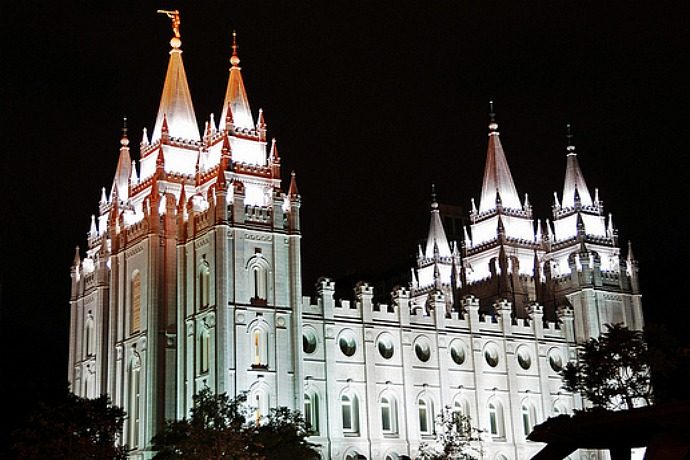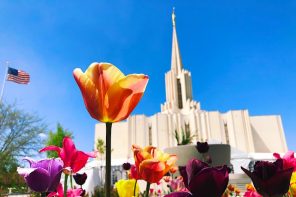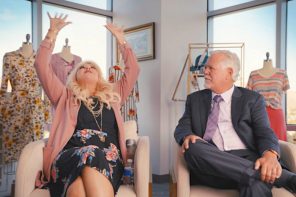In the era of WikiLeaks, the recent “Mormon Leaks” videos of the Church hierarchy being briefed come across as spectacularly boring—like an endless business meeting, complete with lackluster PowerPoints and stultifying statistics. Yet, these dull discussions of otherwise vital and riveting topics, like same-sex marriage, the economy, and science and morality, become fascinating when viewed from the perspective of Mormon history. They portend the likely storms on the horizon of a Mormonism coming of age in an intellectually and socially challenging world.
The new orthodox marriage
In the 19th century, the Mormon practice of polygamy shocked the Christian sensibilities of Americans, who considered it a blatant form of immorality and an offense to God. Mormons, however, argued that it was a religious obligation, which meant that it was protected by the First Amendment. They did not argue that other Christians had to like it, but rather that Mormons had a right to be different—even in the face of intense disagreement, even in the face of animosity due to the apparent immorality of their practices.
In response, anti-polygamy groups drafted an amendment to the Constitution that would “protect” marriage by defining it as between two people. The controversy was settled when the government sent an army West to end the practice.
In light of this history one might be forgiven for having expected the Mormon Church’s position on same-sex marriage to have developed differently. Dial forward a century and a half and we find the Church on the side of religious orthodoxy challenging the right of the LGBT community to do essentially what the Mormons had attempted to do earlier. It was even willing to use the full power of the federal government—including a proposed amendment to the Constitution—to prevail.
There was an elephant in the room during this Mormon Leaks briefing. It entered with the Catholic guest, Professor Robert George of Princeton, whose religious appeals were the same ones used to defeat plural marriage in the 19th century. “There is an assault going on,” George argued, about “what it means to be a human being and whether or not we are under the sovereignty of a transcendent and providential God.” If we are, he continued, “then there are certain non-negotiables,” one being that marriage is “the union of a man and a woman.” Of course, the Catholic “non-negotiables” are not the same, historically speaking, as the Mormon ones, which at one time included the union of a man and many possible women.
Moreover, Professor George’s argument on behalf of children—that they need both a father and a mother—is belied by Mormon experience in which polygamous men had up to 50 and 60 children, living in separate dwellings, and who left their families for years on end to serve missions abroad. Mothers also left their children to pursue professional degrees back East.
Neither was there a deeper discussion about the meanings of contested concepts like “religious freedom,” apart from the concern was expressed for Christians being required to offer their professional services to gay customers.
However, there is precedent in the Mormon community for putting aside religious convictions when engaging in public services. My Mormon uncle opened a chain of Marie Callender restaurants in Utah and procured ecclesiastical approval to serve the public coffee and tea, in clear violation of the Word of Wisdom, and the Marriotts remain in good Mormon standing despite the alcohol in their hotels.
Likewise, there was no sense in the videos of another possible scriptural interpretation of the situation, no re-framing of the issue as one of Christ-like love overcoming religious prejudice concerning a marginalized group.
There was, in fact, no debate at all. And while perhaps this should have been expected, given the face of unity that the Church presents to the world, historically, virulent disagreements have simmered beneath the façade.
Reaching back to founder Joseph Smith, he frequently fought with his apostles—at times excommunicating them, at times apologizing to them for his autocratic behavior. In addition, prophet Brigham Young sparred with apostle Orson Pratt over theological issues, including the very nature of God. That the Church later repudiated Young’s position should give Mormons pause.
So it wasn’t unrealistic to have expected someone to speak on behalf of the gay community. The fact that no evidence of this exists, either in the Mormon Leaks videos or elsewhere, points to a bland uniformity of thought.
A troubling silence on economic issues
Joseph Smith received a revelation that informed him of God’s economy, which was decidedly anti-capitalist. Church historians have noted that Joseph’s economic system “was intended to dispose…of the problem of charity by giving the poor a stewardship over sufficient property to provide for their own wants.” All private property was to be deeded to the Church and then divided up among the heads of families according to their needs. Members would hold their allotted land as stewards. They could manage it as they saw fit, but not sell it or even pass it on to wives and children, and anyone’s land could be subject to division even after the stewardship had been awarded.
Brigham Young continued to implement Joseph’s vision as the beleaguered Saints moved West, and rebelled against such economic axioms as the profit motive, market price and trade.
Despite this economic legacy, voices such as these cannot be found among the Mormon hierarchy today. After the 2008 crash, the Mormon Conference focused on economic issues, but narrowly, stressing individual thrift and endurance rather than taking on socioeconomic structures or public policy.
I had assumed that the silence on the part of today’s Mormon leadership was due to ignorance. It had gotten out of touch.
Mormon Leaks has disabused me of that assumption. Elder Gerrit W. Gong briefed the leadership on the shenanigans in the financial world and warned of a possible “perfect storm,” including the “time bombs” of credit default swaps. Elder Gong explained that they were “gaming contracts,” “financial weapons of mass destruction,” and that they represented a tremendous “moral hazard.”
Elder Robert Hales spoke of a “delusion of collusion” involving financiers and multiple insurance houses that together deceived investors concerning these defective instruments. Yet, the only response to these grave realities was to suggest that the “perfect storm” might have an impact on the ability of senior couples to serve missions.
Science of morality… immoral
In 1966, 25-year-old Charles Whitman went on a killing spree at the University of Texas. In a suicide note left behind, Whitman asked that an autopsy be conducted on his body as he was convinced that something biological accounted for his actions. The autopsy found a tumor on his brain that was suspected of preventing him from controlling his emotions and behavior.
Whitman’s is just one of many cases in which a compromised brain has seemed to result in a changed personality and subsequent anti-social behavior. The implications of these findings are tremendous. They raise questions concerning human freedom, personal responsibility, and thus accountability; all of which have religious ramifications.
Yet, this briefing witnessed a total lack of curiosity about such issues, as Elder Gong informed the Mormon leadership of what he considered to be a dangerous scientific development. A science of morality was considered to be a threatening “contradiction” that would “explain away” conscience. Thus was lost any deepening that new information may have had on our humility, compassion, and ability to love. Moreover, the discussion once again stands in stark contrast to early Mormon leaders who considered themselves on the cutting edge of science.
A mixed bag hierarchy
The Mormon Leaks videos exposed a hierarchy at once anachronistic and advanced. On the one hand, it was odd to watch executive meetings composed entirely of white males in their senior years wearing suits and ties, and their concerns—the age at which their youth marry (too old) and how many children they have (too few)—would puzzle most onlookers.
On the other hand, their discussions of enhanced leadership roles for women and of multicultural issues was somewhat advanced. Granted, these were confined within the bounds of a patriarchal church that hopes to convert those of other faiths. Yet, sincerity and genuine concern prevailed. The brethren expressed considerable unease about a destructive bias in the news concerning Islam and deemed it imperative that the Mormon faithful be sensitive to Muslims and properly educated as to their beliefs.
These aspects of the Mormon Leaks videos resonate with my own grassroots experience of the faith as an earnest community that seeks to be of service, and especially to be kind. While this may seem to clash with positions taken regarding homosexuality, it may have more to do with the power of ideas than ill will. The Church may draw on these religious resources to successfully manage the likely storms to come.





